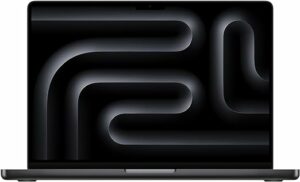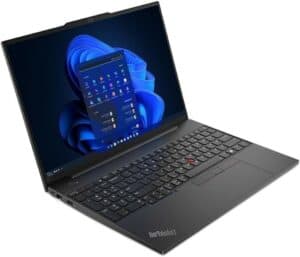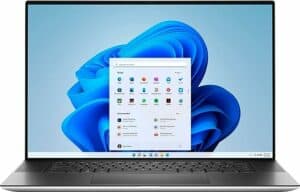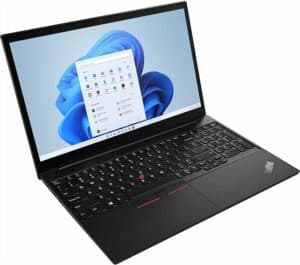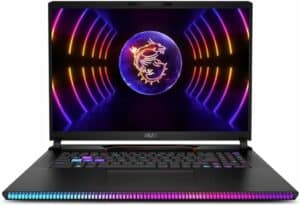Best desktop replacement laptop in 2025 – our top picks
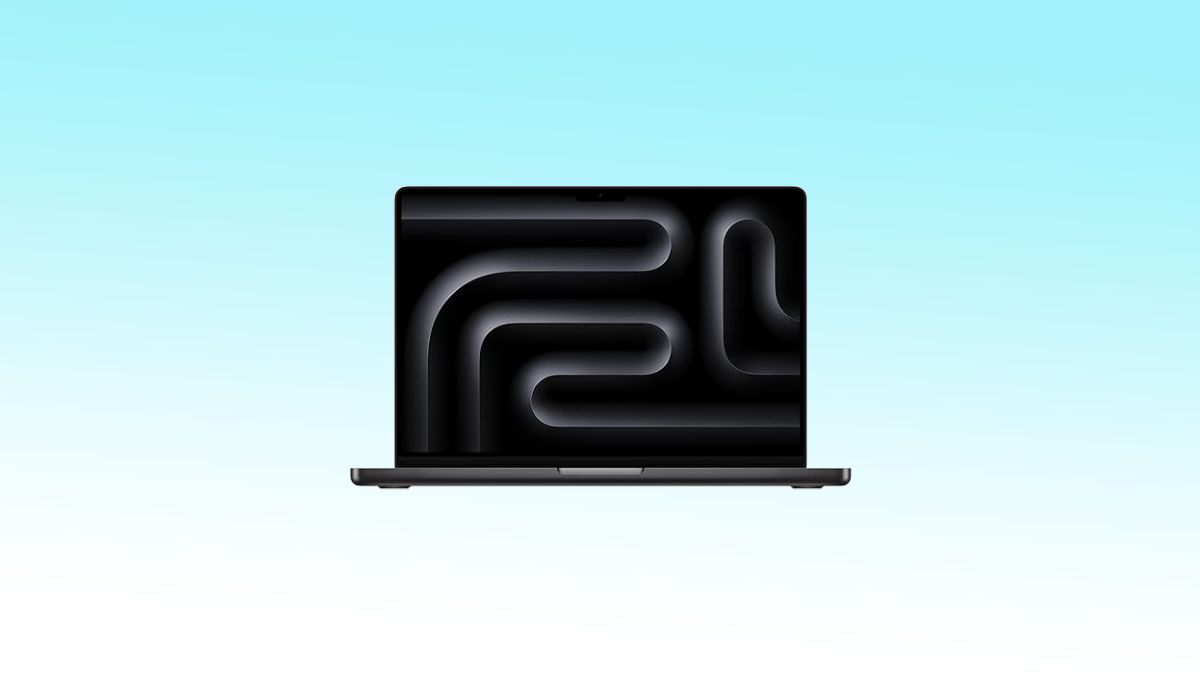
Table of Contents
If you’re on the hunt for the best desktop replacement laptop, we’ve got you covered.
Laptops these days come in all shapes and sizes, and some of them can serve as an excellent desktop replacement. These laptops are meant for those who are always on the go and want something that can do the same tasks as their desktop.
Now, the kind of laptop you should get depends on your needs. If you only want something for basic stuff, you can go with a laptop that isn’t too fancy. But for demanding tasks, you’ll need to opt for a laptop that comes equipped with powerful components, like Intel 13th-gen CPUs or RTX 30 or 40-series GPUs. On top of that, demanding tasks also require a good amount of RAM, preferably 16 or 32GB.
To help you kick off your search in the best way possible, we did our research and selected a few options we think are the best desktop replacement laptops. We selected them based on their specs like GPU, CPU, RAM, storage, and other notable features that make them shine among the crowd.
So, without wasting another second, let’s dive into the list of the best desktop replacement laptops.
Products at a Glance
How We Picked
We’ve used our expertise to find the best desktop replacement laptops currently available in the market. These laptops have been selected based on their specs, features, and the value for money they offer. We are also constantly looking for new laptops to add to our list, so make sure to check back here soon to explore more options.
Product Reviews
- M3 Max chip
- Gorgeous 16.3-inch display
- 22 hours of battery life
- Expensive
If budget is not an issue and you want a premium laptop that can handle whatever you throw at it, we’d recommend the Apple MacBook Pro 2023 with an M3 Max chip. This laptop ticks every box of what a high-end desktop replacement laptop should have.
The laptop is powered by the M3 Max chip, which features a 14-core CPU and 30-core GPU, thanks to which it can handle demanding tasks smoothly. On top of that, it comes with 36GB of RAM, which will be more than enough for productivity tasks. In fact, these specs make it a strong contender for one of the best laptops for video editing and the best laptops for photo editing.
As for the display, the MacBook Pro comes with a 16.2-inch Liquid Retina XDR display, which offers 600 nits of max brightness for SDR content, and it goes up to 1000 nits for HDR content. This makes it perfect for those who like using their laptop outdoors or under bright settings.
Overall, the MacBook Pro with M3 Max chip is the best desktop replacement laptop currently available in the market. It also features an amazing battery life of up to 22 hours, which makes it on par with some of the best battery life laptops.
- Budget option
- Decent processor
- Webcam
- Storage may be low for some users
If you don’t want something high-end and just want a laptop that can help you push through daily tasks smoothly, you’d want to check out the Lenovo ThinkPad E16 2023.
The laptop is powered by the AMD Ryzen 7530U, which is an excellent processor for multitasking. While it may not be the most powerful processor, it still gets the job done smoothly. On top of that, for fast processing speeds, the laptop boasts 16GB of DDR4 RAM paired with a 256GB SSD. While the storage may be enough for some users, you can take it up to 2TB by throwing in some extra bucks.
The Lenovo ThinkPad E16 2023 does not disappoint when it comes to the display, as it sports a 16-inch WUXGA IPS screen with 300 nits of peak brightness. There’s also a 1080p webcam in case you’re always doing meetings. Overall, we think the Lenovo ThinkPad E16 is the best budget desktop replacement laptop. It also features a battery life of up to 14 hours, which is another reason why you should get it. In case you want to explore more budget options, check out our top picks for the best budget laptops.
- 17-inch display with a UDH+ resolution
- RTX 3060 and Core i7-12700H
- 32GB RAM
- Display is only 60Hz
The XPS series from Dell is well known for featuring some of the best laptops in the market. As for the Dell XPS 17, it packs a punch in the performance department, and we think it is the best 17-inch desktop replacement laptop.
For the GPU and CPU, the Dell XPS 17 features the RTX 3060 6GB and the Intel Core i7-12700H processor, which belongs to the 12th-gen lineup of CPUs from Intel. On top of these, the laptop features a 1TB SSD for storage and 32GB of DDR5 RAM to help you push through resource-hungry tasks.
As far as the display is concerned, like some of the best 17-inch laptops, the Dell XPS 17 has a gorgeous 17-inch display with a UDH+ resolution. The display is also pretty bright, as its brightness can go up to 500 nits. As for the refresh rate, it is only 60Hz. But this won’t be a problem, considering the laptop isn’t meant for gaming anyway, which usually requires a high refresh rate. Even though the laptop sports a 17-inch display, its battery life is still pretty decent, as it can last up to 9 hours. This, of course, will depend on how you use it.
Overall, the Dell XPS 17 is an excellent choice for those looking for a 17-inch desktop replacement laptop.
- Lightweight
- Decent processor
- Good battery life
- Storage may be low for some users
Business laptops are meant to be something that are easy to carry and have a great battery life. As for the Lenovo ThinkPad E15 Gen 4, it ticks both boxes. In fact, we think it deserves to be one of the best business laptops.
For the processor, we have the 12th-gen Intel Core i5-1240P processor, featuring the Intel Iris Xe Graphics. For the RAM, we have 16GB of DDR4 RAM, which will be more than enough for most tasks. The storage may be low for some users, as the variant we selected comes with a 512GB SSD. However, by spending some extra bucks, you can take it to 1TB.
The Lenovo ThinkPad E15 Gen 4 has a 15.6-inch full HD screen. It has an anti-glare coating, which reflects light, making it usable in well-lit environments. The laptop also lasts for up to 8 hours after a single charge, and it weighs only 3.75 pounds, which makes it portable. Overall, we think that the Lenovo Thinkpad E15 Gen 4 is the best business desktop replacement laptop thanks to its components, weight, and great battery life.
- RTX 4090 GPU and Intel i9-1390HX CPU
- 64GB DDR5 RAM and 2TB SSD
- 17-inch 240Hz display
- Expensive
The MSI Raider GE78HX is the best choice for those who are looking for a gaming desktop replacement laptop. It features some of the most powerful components and can help you run almost every game at high graphical settings while maintaining high frame rates.
The MSI Raider GE78HX is powered by the 13th-gen Intel i9-1390HX processor, which is one of the most powerful processors available for laptops, as it can handle CPU-intensive tasks smoothly. For the GPU, we have the RTX 4090, which is currently the most powerful GPU offered by NVIDIA for gaming.
There’s also 64GB of DDR4 RAM paired with a 2TB SSD, which further contributes to the overall performance of the PC. Coming down to the display, the laptop sports a 17-inch QHD+ IPS display with a refresh rate of 240Hz. Overall, we think that the MSI GE78H is the best gaming desktop replacement laptop, and it deserves to be one of the best gaming laptops.
Things to choose the best desktop replacement laptop
As we said, there are a bunch of things you need to consider before making the switch from desktop to laptop. The major reason is that laptops have to lower the power consumption of desktop equivalent components. If you had full-powered desktop components inside a high-end laptop, you’d need a car battery to keep it powered for longer than 20 minutes and a charging brick the size of a cinder block.
The components we need to take into consideration are the CPU, the GPU, the screen, the memory and storage, and extra features like the cooling system, keyboard, build materials, etc.
CPU
The CPU is essentially the brain of your PC; it is the thing that controls all actions and is responsible for carrying out your every command. How powerful your CPU is determines how smoothly the computer runs as a whole. As we said above, laptop components are usually underclocked and underpowered to reduce their overall power consumption. The obvious downside to this is that this also reduces performance.
Thankfully, with CPUs, it is normally only the base performance that is reduced, and with adequate equipment, it is definitely possible for you to gain almost desktop levels of performance without having to overclock it.
There are 2 measures of how ‘powerful’ a CPU is: the clock speed and the core count. The clock speed is a metric measure of how fast the processor is. It does this by measuring how many cycles/calculations it can do in a second; this is why it is measured as a frequency in Hz. There are 2 different clock speeds that a CPU is advertised with, its base clock and its boost clock.
The base clock is essentially the lowest possible speed of the processor regardless of power draw or temperature. The boost clock is the speed at which the CPU is capped across all cores. The boost clock is hugely dependent on the temperature and power draw, if you have adequate cooling and enough of a charge the laptop can tell the CPU that it’s safe to ramp up. Increasing the speed also increases the thermal output so a CPU cannot sustain its boost clock without amazing cooling.
The core count is exactly how it sounds; it is a count of how many cores your processor has. A CPU core is basically a mini-processor that comes together with other mini-processors to make a whole CPU. The more cores you have, the more programs and applications the computer can allocate to them, increasing efficiency and performance. The issue with more cores is that the more cores you have, the higher your thermal output, meaning the better your cooling needs to be.
Finding the best laptop CPU is as much about finding a good balance as it is finding the most powerful, balls-to-the-wall processor you can possibly find.
GPU
The GPU or Graphics Processing Unit is a normally forgotten part of a good laptop. Your GPU controls what is shown on your screen; if it’s on the screen, it has been processed by the GPU. Most CPUs and motherboards have a version of integrated graphics that they use to simply show things on screen, but they normally aren’t powerful enough to run any type of games or graphics-intensive software like Premiere Pro or Blender.
Desktops that have been purpose-built for graphics-heavy software or gaming will always have a dedicated GPU that can be removed and upgraded as you need to. These are vital for smooth production in Blender, for speedy renders in Sony Vegas, and decent playable frame rates in games.
Similar to CPUs, the mobile/laptop version of a GPU is often underclocked and undervolved to increase efficiency. The newer generations of GPUs have been able to retain a large portion of their performance whilst still being relatively power efficient. Again, it’s important to find the right balance between power and performance with mobile graphics cards.
They are also measured by their clock speeds and core counts, but GPUs have the unique problem of having thousands of cores and cores of different types. To make it simple, we’re going to set a recommendation based on the VRAM which is the cacheable memory of a graphics card and impacts resolution production. We’d say 3GB of VRAM should be a minimum to get a reasonable amount of performance out of a laptop; in previous generations, this would not have been enough, but newer graphics cards can do a lot with less.
If you’re not planning on running any visual software, then a graphics processor isn’t going to be that useful to you, but as we said, to achieve the same versatility as a desktop, it’s worth having a GPU anyway as it will boost visual performance all around especially if you like watching high res content. We recommend checking out the best gaming laptops under $3000 as they feature some of the most powerful GPUs.
Screen
The monitor of your laptop is a fairly obvious one. The biggest difference between a laptop and a desktop is that you can’t change your monitor. You’ll most likely always be able to power an external display with your laptop, but the screen it comes equipped with is the one you’re going to use while you’re on the move, so it’s very important to make sure you have a good monitor.
We judge our screen by 3 different metrics: its resolution, its panel type, and its size. If we were solely looking at gaming laptops, then the refresh rate would be important, but we’re looking at all-rounders, so we’ll just say that the higher the refresh rate, the better.
The resolution is how sharp the image is overall, the panel type determines the color accuracy and viewing angles, and the size is subjective to you. If you want a bigger screen, then a 17.3” laptop is going to be your best bet, but if you’re looking for portability, then a 15.6” or 13” one would be best. All of these metrics are subjective to you, but with most, the higher the number, the better it is. In case you want to explore even bigger options, check out our top picks for the best 18-inch laptops.
With panel types, however, there are 2 main types that we’ve looked at: VA and IPS. VA can be run at higher refresh rates easily and offers decent color accuracy. IPS panels are brighter and have way better color accuracy, so it’s completely up to you which is better.
Memory and Storage
The memory is the amount of RAM your system has and acts as the short-term memory of the laptop. The more you have, the more things you can have going on concurrently. There is no hard limit on how much you should have, but the standard user will never need more than 16GB, and even enthusiast-level builds will have a max of 32 GB.
The storage is the total long-term memory of your laptop and determines how many things you can save onto the laptop directly or how many programs you can have installed at the same time. The more you can have, the better, but a laptop is limited by the amount of space the chassis has; newer storage modules have been able to shrink down to 40mm NVME chips, and you’ll usually have a free slot for expansion later on down the line.
The memory and storage are usually the only upgradeable parts of a laptop.
Extra Features
These aren’t necessarily vital features but features that improve the quality of the laptop nonetheless. Things like a gaming-based cooling system or a large I/O can make a big difference to the versatility of the laptop.
Our Verdict
For us, the Apple MacBook Pro with M3 Max chip is the best desktop replacement laptop. It can handle whatever you throw at it thanks to its powerful M3 Max chip and 36GB of RAM. On top of that, it has a gorgeous 16.2-inch Liquid Retina XDR display, which should deliver clear, crisp visuals.

